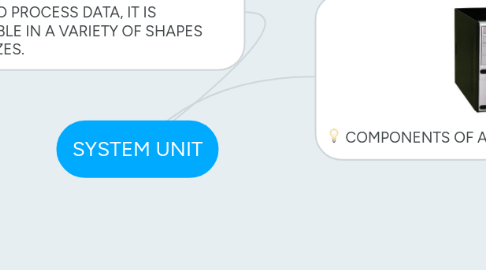
1. COMPONENTS OF A SYSTEM UNIT
1.1. MOTHERBOARD
1.1.1. Is is the foundations for the PC.
1.1.2. Every piece of hardware from the CPU to the lowest expansion card directly or indirectly plug into the motherboard.
1.1.3. Contains wires called traces, that make up the buses of the system.
1.1.4. Three variables and interrelated characteristrics define modern motherboards.
1.1.4.1. Form factor
1.1.4.1.1. determines the physical size of the motherboard & general location of components and ports.
1.1.4.2. chipset
1.1.4.2.1. defines the types of processor and RAM requires.
1.1.4.2.2. determines what built-in devices the motherboard supports, including expansion-slots.
1.1.4.3. components
1.1.4.3.1. defines the core functionality of the system.
1.2. CPU
1.3. RANDOM ACCESS MEMORY (RAM)
1.3.1. A computer storage location that allows information to be stored and accessed quickly from random location.
1.3.2. It is faster to access files on a RAM
1.3.3. highly volatile and requires power to store data. memory is lost when power is off.
1.4. helps cpu work wth RAM on intel-traditional motherboard.
1.5. CHIPSET
1.5.1. every motherboard has one or more integrated chipset to support the cpu that interfaces all other devices on the motherboard.
1.5.2. the chipset determines the Processor's type, RAM's type and capacity and the type of internal and external devices the motherboard supports.
1.5.3. consists of two primary chips
1.5.3.1. northbridge
1.5.3.1.1. on newer motherboard, CPU takes control of memory controlling, it is either non-existent or just provides communication with video cards.
1.5.3.1.2. requires its own heatsink & fan as it does a lot of tasks thus getting hot.
1.5.3.2. southbridge
1.5.3.2.1. handles expansion devices and mass storage drives such as hard drive.
1.5.3.2.2. does not need extra cooling.
1.5.3.3. Super I/O chip
1.5.3.3.1. SIO or super input output chip is an integrated circuit that handles the slower and less important i/o devices such as floopy disk, modems and infrared communication.
1.5.3.3.2. in newer motherboards it communicates with the southbridge chip in order to support legacy devices.
1.6. EXPANSION SLOTS
1.6.1. a socket on the motherboard that holds adapter cards
1.6.2. adapter card is also known as expansion cards.
1.6.3. exhances the functions of a component of a system unit or provides connection to peripherals.
1.7. EXPANSION / ADD-ON CARDS
1.7.1. example of add on cards are sound card and video cards
1.7.2. older motherboards may require adapter cards to provide capabilities such as enhanced sound and video.
1.7.3. newer computers supports plug & play that automatically configure adapter cards and peripherals when installed.
1.7.4. plug and play means user can just plug in devices and start using them. such as a mouse, keyboard, etc
1.8. PORTS & CONNECTORS
1.8.1. a port is a where a peripheral attached to or communicate with the system unit. it is used to send or receive information from the compyter
1.8.2. connector joins a cable to a port. one end to the peripheral and the other to be slotted to the ports of a system unit.

